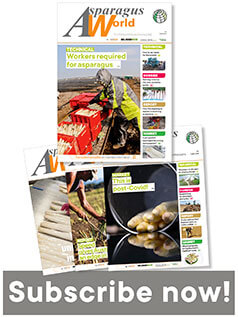Asparagus in the age of Brexit
Britain’s asparagus sector is at a critical juncture, with its very survival in the balance, assailed on all sides by a combination of rising costs and labour shortages fuelled by political uncertainty. The sector had previously been in a healthy state, having grown rapidly in the past 15 years, from 1,000 hectares in 2005 to 3,200 hectares in 2019, making it northern Europe’s largest producer. There are around 150 asparagus producers in the UK growing exclusively green varieties. The country’s asparagus is reputed to be among the best in world, but the sector is heavily dependent on seasonal migrant labour, mainly from Eastern Europe. The British fruit and vegetable sector relies on up to 80,000 seasonal workers arriving from the EU each year. While once the country was awash with applications for work on its farms, the post-Brexit climate in the UK is less accommodating of these migrants and a less appealing work destination. Indeed, labour agencies report a significant drop in interest in 2017 and 2018, with Romanian and Bulgarian workers in particular opting to go elsewhere in the EU where communities are more welcoming and employment conditions involve less uncertainty. The new immigration reforms recently announced by the government specifically restrict entry to the UK to unskilled labourers and appear highly likely to exacerbate the current problems faced by the agricultural sector.
UK losing its shine as an employment destination
Besides the less welcoming environment in the UK for foreign workers, there are also financial reasons for these migrants to look towards the UK’s neighbours instead. The fall in the value of the British pound against the Euro makes salaries in Germany and France more attractive. And the lack of workers could lead to a form of internecine warfare within the UK farming sector. As Doug Amesz of AG Recruitment points out, it is the entire UK agricultural industry that is facing labour shortages, so British asparagus producers are not only forced to compete with other asparagus producers to hire workers but also with producers in other sectors. “There are increasing immigration dossier constraints and increasing competition from other sectors,” said Amesz at the 2019 British Asparagus Conference.
“No migrant labour, no asparagus”
There has been a shortfall of around 10,000 workers over the past two seasons, which has forced farms to increase wages and bonuses. British farms typically pay workers the national minimum wage of £7.83 an hour plus performance-related bonuses. According to Concordia, a labour agency charity that recruits EU pickers for British farms, UK agriculture is entering a period of crisis. Speaking to Reuters, chief executive Stephanie Maurel said, “No labour means no harvesting, which means no fruit and no vegetables on the shelves of British supermarkets.” And the country’s retailers appear unlikely to rush to the aid of the struggling producers, as sales volumes are negotiated in advance for the season and prices are fixed, barring exceptional circumstances.
New sources of labour in the East
The working conditions currently on offer have so far been unable to attract British workers to fill the gap left by the migrants and this is likely to remain the case for the foreseeable future, as the lure of the agriculture sector struggles to compete with that of other sectors. In a bid to overcome the lack of workers from the EU, the British government has recently sanctioned a pilot trial for 2,500 workers to enter the country from Russia, Ukraine and Moldova for up to six months over the next two years. This new pool of labour could prove to be just the lifeline that the benighted sector needs right now. The bottom line is that if there are no migrant workers in the UK, there will be no locally grown asparagus and, ironically, after Brexit, the British people will actually become more dependent than ever before on Europe if they wish to continue to enjoy the vegetable that they so adore.
Opportunities for Peruvian asparagus
The UK is a net importer of asparagus – in fact, none of the precious home-grown product is sold abroad. Total imports reached just over 13.9 million tons in 2014, before steadily falling to approximately 12.1 million tons in 2017, then recovering to around 13.2 million tons in 2018. The main source is Peru, which ships between 8,000 and 10,000 tons to the UK every year, worth around US$60 million. Some distance behind Peru comes Mexico (around 2,000 tons per season), followed by Spain (around 1,000 tons). The total value of the UK’s asparagus imports fell from US$77.3 million in 2015 to 73.7 million in 2019. Producers in these countries will no doubt be keeping a close eye on developments in the lucrative UK asparagus market over the coming months.
| Exporters | Imported value in 2015 | Imported value in 2016 | Imported value in 2017 | Imported value in 2018 | Imported value in 2019 |
| World | 77313 | 77966 | 75698 | 75684 | 73742 |
| Peru | 61090 | 62081 | 57504 | 59574 | 55258 |
| Mexico | 7671 | 8812 | 12012 | 10948 | 15004 |
| Spain | 3013 | 2241 | 1120 | 1286 | 1002 |
| Netherlands | 1059 | 866 | 751 | 560 | 737 |
Source: ITC
Value of UK asparagus imports (thousands of US dollars)

A British speciality
The British are fiercely proud of their asparagus; so much so that when UK retail chain Tesco began selling imported Peruvian asparagus in the Vale of Evesham, Worcestershire (considered the heart of the UK’s asparagus sector), shoppers threatened to boycott the supermarket over its lack of support for British farmers. Britain’s asparagus season is relatively short, traditionally beginning on St George’s Day (23rd April) and ending on Midsummer Day (21st June). During this period, premium British asparagus is in great demand, with £23 million spent on green varieties. It is believed that asparagus was first introduced to the island by the Romans, but the varieties grown today are the French type of asparagus that arrived in Britain in the seventeenth century. The southern British climate is ideal for the slow growth of a sweet and tender asparagus. Demand for home-grown product is so high that there is never anything left to export outside the UK. The asparagus season is celebrated across the country; the Vale of Evesham holds an annual week-long festival with auctions of the best crop and locals dressing up as spears of asparagus. British consumers are still less familiar with white asparagus, which is so highly prized in parts of Europe continent, but this kind is now becoming something of a gourmet product in UK retailers and trial programmes have been run in growing the product in the UK, such as at Cobrey Farm, in the Wye Valley, Herefordshire.
More Info
The same concerns
Asparagus is mainly produced in the south of the UK on different sized farms, from just a few hectares to 800 hectares in area. Regardless of size, they all face the same concerns, rising costs and labour shortages. As is the case everywhere in Europe, harvesting and packaging represent the most costly activities for British asparagus producers, with costs roughly equivalent to those of French producers
























